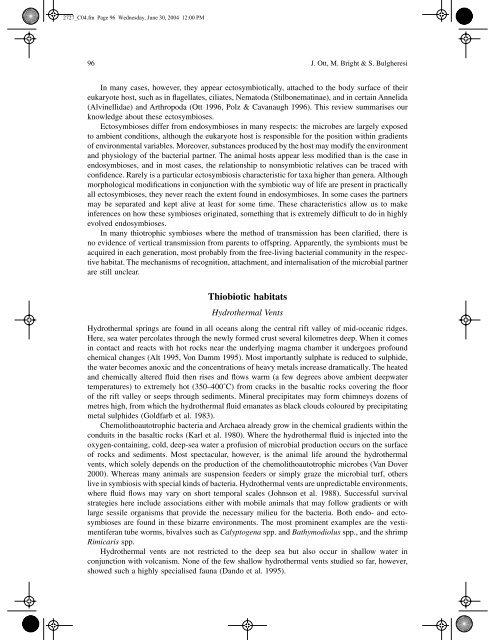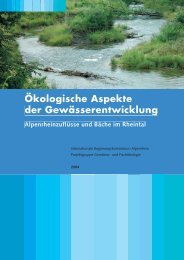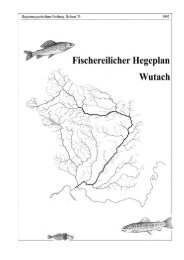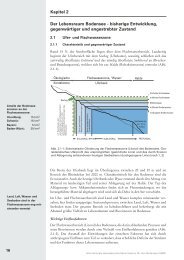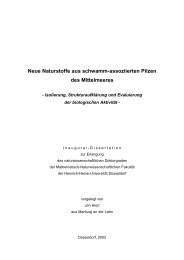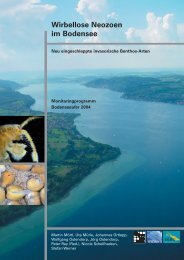marine microbial thiotrophic ectosymbioses - HYDRA-Institute
marine microbial thiotrophic ectosymbioses - HYDRA-Institute
marine microbial thiotrophic ectosymbioses - HYDRA-Institute
You also want an ePaper? Increase the reach of your titles
YUMPU automatically turns print PDFs into web optimized ePapers that Google loves.
2727_C04.fm Page 96 Wednesday, June 30, 2004 12:00 PM<br />
96 J. Ott, M. Bright & S. Bulgheresi<br />
In many cases, however, they appear ectosymbiotically, attached to the body surface of their<br />
eukaryote host, such as in flagellates, ciliates, Nematoda (Stilbonematinae), and in certain Annelida<br />
(Alvinellidae) and Arthropoda (Ott 1996, Polz & Cavanaugh 1996). This review summarises our<br />
knowledge about these <strong>ectosymbioses</strong>.<br />
Ectosymbioses differ from endosymbioses in many respects: the microbes are largely exposed<br />
to ambient conditions, although the eukaryote host is responsible for the position within gradients<br />
of environmental variables. Moreover, substances produced by the host may modify the environment<br />
and physiology of the bacterial partner. The animal hosts appear less modified than is the case in<br />
endosymbioses, and in most cases, the relationship to nonsymbiotic relatives can be traced with<br />
confidence. Rarely is a particular ectosymbiosis characteristic for taxa higher than genera. Although<br />
morphological modifications in conjunction with the symbiotic way of life are present in practically<br />
all <strong>ectosymbioses</strong>, they never reach the extent found in endosymbioses. In some cases the partners<br />
may be separated and kept alive at least for some time. These characteristics allow us to make<br />
inferences on how these symbioses originated, something that is extremely difficult to do in highly<br />
evolved endosymbioses.<br />
In many <strong>thiotrophic</strong> symbioses where the method of transmission has been clarified, there is<br />
no evidence of vertical transmission from parents to offspring. Apparently, the symbionts must be<br />
acquired in each generation, most probably from the free-living bacterial community in the respective<br />
habitat. The mechanisms of recognition, attachment, and internalisation of the <strong>microbial</strong> partner<br />
are still unclear.<br />
Thiobiotic habitats<br />
Hydrothermal Vents<br />
Hydrothermal springs are found in all oceans along the central rift valley of mid-oceanic ridges.<br />
Here, sea water percolates through the newly formed crust several kilometres deep. When it comes<br />
in contact and reacts with hot rocks near the underlying magma chamber it undergoes profound<br />
chemical changes (Alt 1995, Von Damm 1995). Most importantly sulphate is reduced to sulphide,<br />
the water becomes anoxic and the concentrations of heavy metals increase dramatically. The heated<br />
and chemically altered fluid then rises and flows warm (a few degrees above ambient deepwater<br />
temperatures) to extremely hot (350–400˚C) from cracks in the basaltic rocks covering the floor<br />
of the rift valley or seeps through sediments. Mineral precipitates may form chimneys dozens of<br />
metres high, from which the hydrothermal fluid emanates as black clouds coloured by precipitating<br />
metal sulphides (Goldfarb et al. 1983).<br />
Chemolithoautotrophic bacteria and Archaea already grow in the chemical gradients within the<br />
conduits in the basaltic rocks (Karl et al. 1980). Where the hydrothermal fluid is injected into the<br />
oxygen-containing, cold, deep-sea water a profusion of <strong>microbial</strong> production occurs on the surface<br />
of rocks and sediments. Most spectacular, however, is the animal life around the hydrothermal<br />
vents, which solely depends on the production of the chemolithoautotrophic microbes (Van Dover<br />
2000). Whereas many animals are suspension feeders or simply graze the <strong>microbial</strong> turf, others<br />
live in symbiosis with special kinds of bacteria. Hydrothermal vents are unpredictable environments,<br />
where fluid flows may vary on short temporal scales (Johnson et al. 1988). Successful survival<br />
strategies here include associations either with mobile animals that may follow gradients or with<br />
large sessile organisms that provide the necessary milieu for the bacteria. Both endo- and <strong>ectosymbioses</strong><br />
are found in these bizarre environments. The most prominent examples are the vestimentiferan<br />
tube worms, bivalves such as Calyptogena spp. and Bathymodiolus spp., and the shrimp<br />
Rimicaris spp.<br />
Hydrothermal vents are not restricted to the deep sea but also occur in shallow water in<br />
conjunction with volcanism. None of the few shallow hydrothermal vents studied so far, however,<br />
showed such a highly specialised fauna (Dando et al. 1995).


